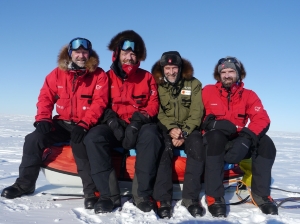There was a lot more going on in 1911 “Forget it! There’s no way we can stay on course with this wind.” Our ski-sailing expert from Kirkenes lowers his kite to the ground. “Damn!” think some of us, “another day of slogging.”
“Continued the climb. The first short sharp slopes led us to the uppermost pass between the closest coastal mountains. They are about 4,000 ft. high.”– Amundsen on this day 100 years ago (Read more …) 
Yesterday everything was so great. Okay, the wind direction wasn’t perfect then either. Harnessing the wind took all our strength and our leg muscles were stiff with the effort. But it offered a bit of variety. Raise your kite. Concentrate on getting it to fly properly. Read the wind, read the terrain. Fall down and get back up again. A bit of “action”. But today we’re back to pulling our sleds – infinitely more monotonous work. Isolated in our hoods like horses in blinkers, we are alone with our own thoughts an hour at a time. We drive ourselves hard when we are on the move. One hour of pulling; not a minute less. Discipline befitting Olympic athletes. And then a juice break. In principle, breaks last ten minutes, but this time limit isn’t as strictly kept. Then we raise the hoods again, put on our snow goggles and count down the minutes until the lead man starts to check the time again. And eventually lets us know that another hour has passed. It gets monotonous, we must admit, but it does make the kilometres add up. Eight sessions per day. Amundsen’s expedition included so many more elements. They drove a few hours in the morning and covered 37 kilometres. Then the dogs had to rest, but the day’s driving was already behind them. We don’t mean to insinuate that it was easy to get to the South Pole in 1911. But they did lots of different things along the way. Built cairns, organised depots, checked their position, fed the dogs. Slaughtered the dogs too, for that matter. And they didn’t ski pulling heavy sleds behind them. Amundsen even complained, on reaching the end of the Ross Ice Shelf: “We were quite unaccustomed to skiing, even though we had just put 620 km behind us on skis. We had been towed the whole way and were now out of shape.” Seen from this perspective, modern polar excursions are more reminiscent of the way Scott conducted his expedition than of Amundsen’s demonstration of polar efficiency. Position: S 83 51.032, W 163 51.247
Temperature: -18°C Wind: 5-8 m/s from the south Distance traversed: 32 km Distance behind Amundsen: 177 km Did you know that Bouvetøya is the most isolated island in the world?
Bouvetøya is a Norwegian island in the South Atlantic. The closest land mass is Dronning Maud Land in Antarctica, 1 700 km farther south. |
South Pole 1911–2011 is an informational outreach project run by the Norwegian Polar Institute
Contact person:


